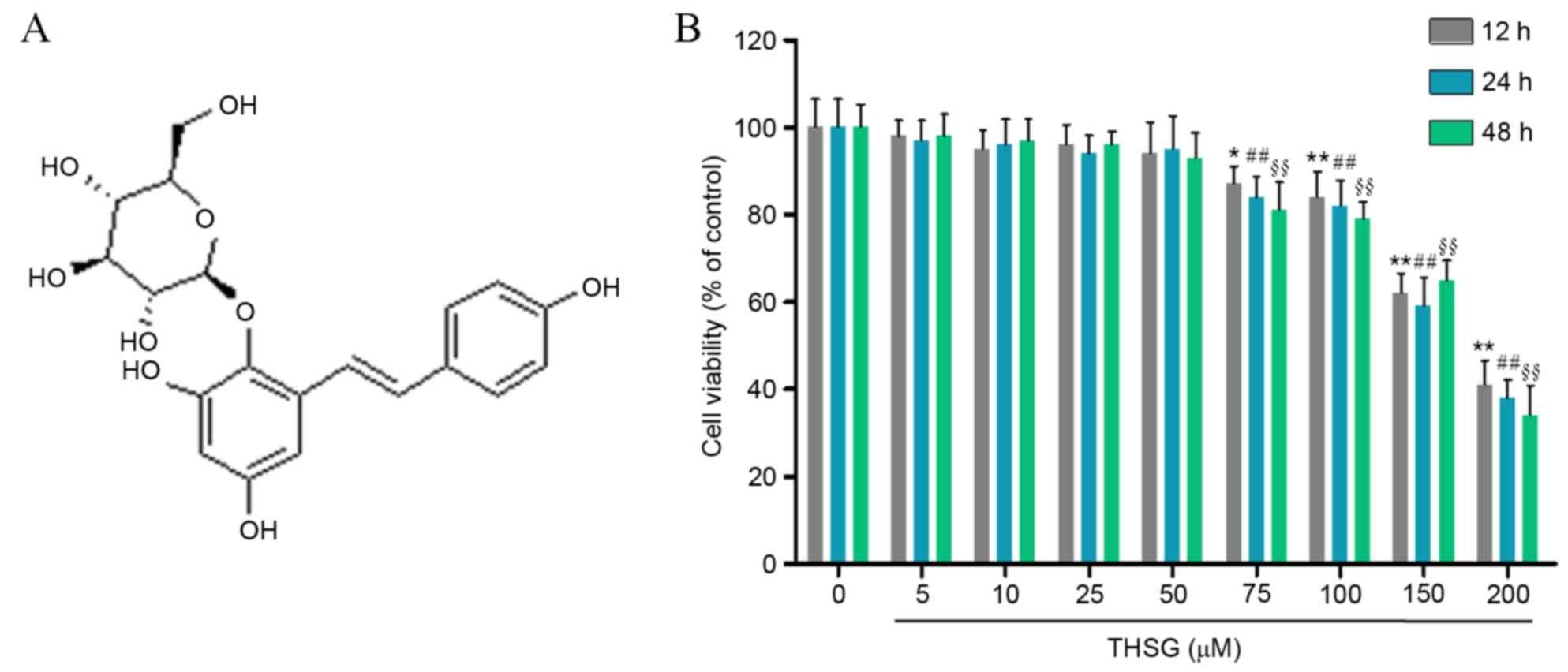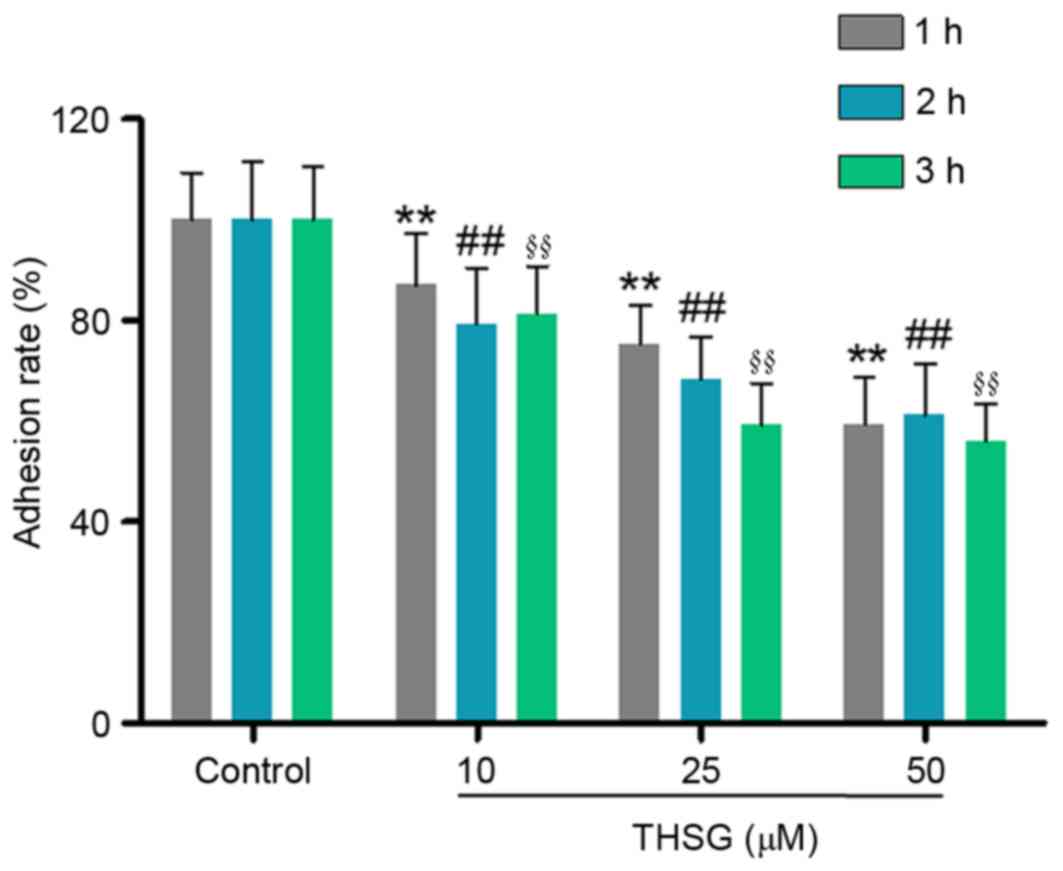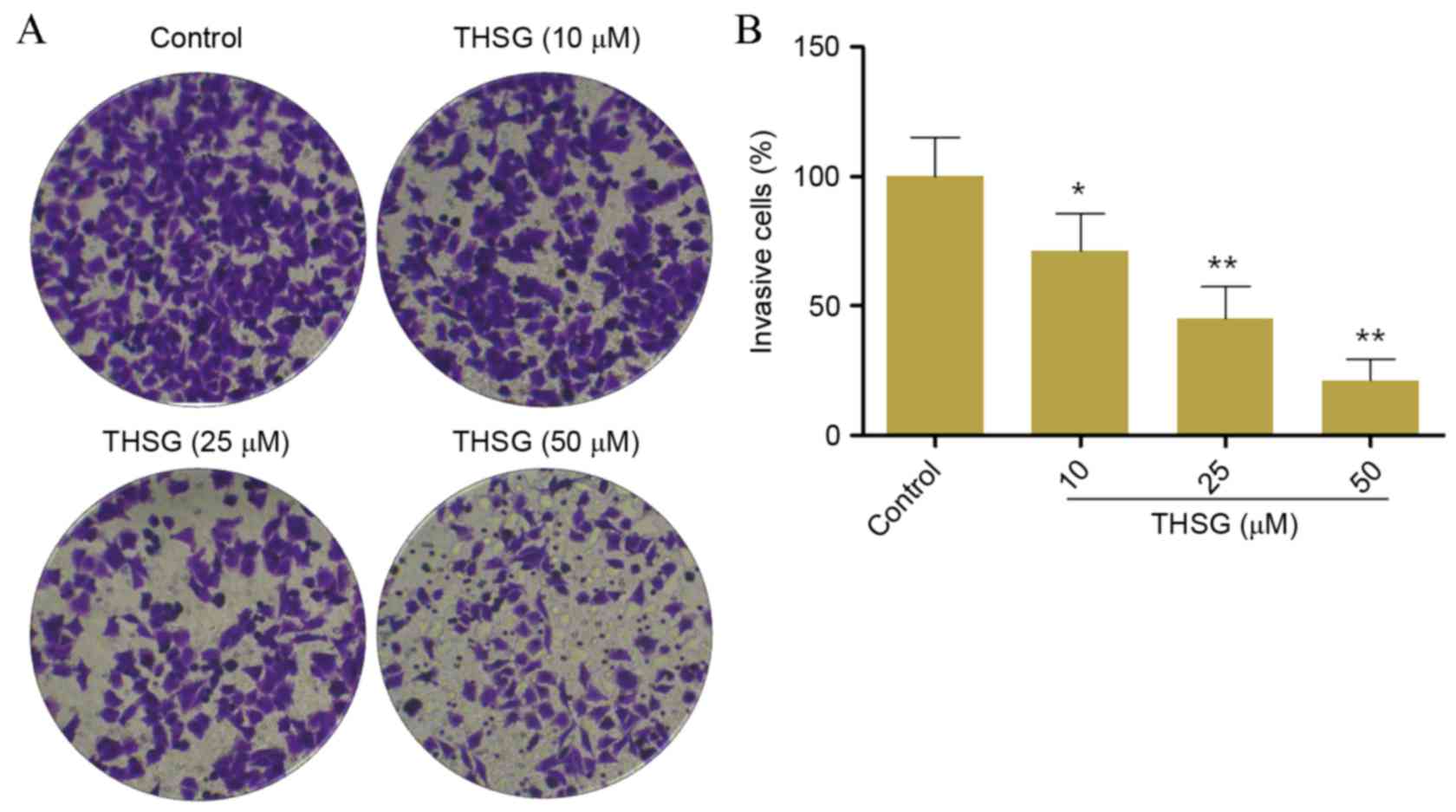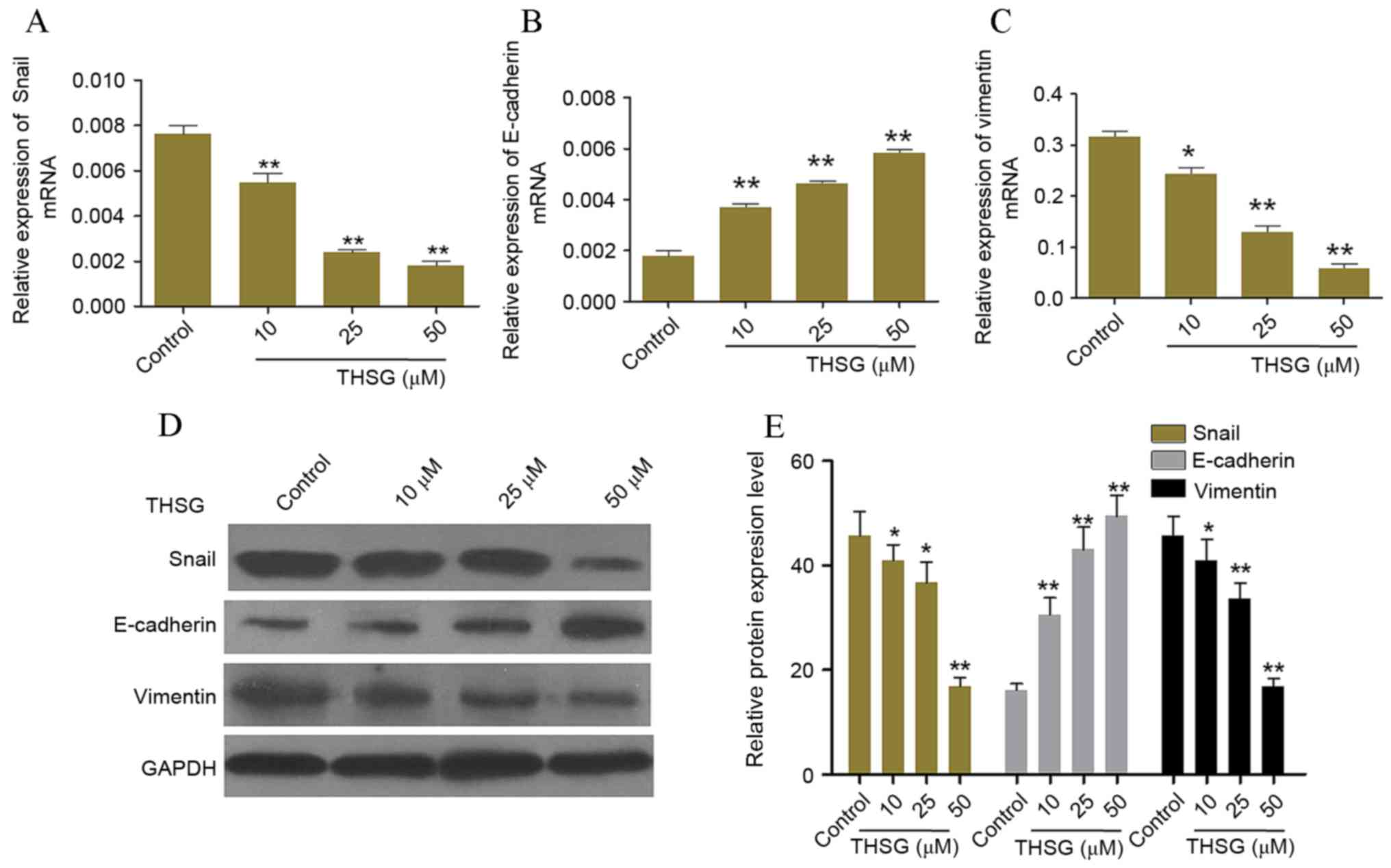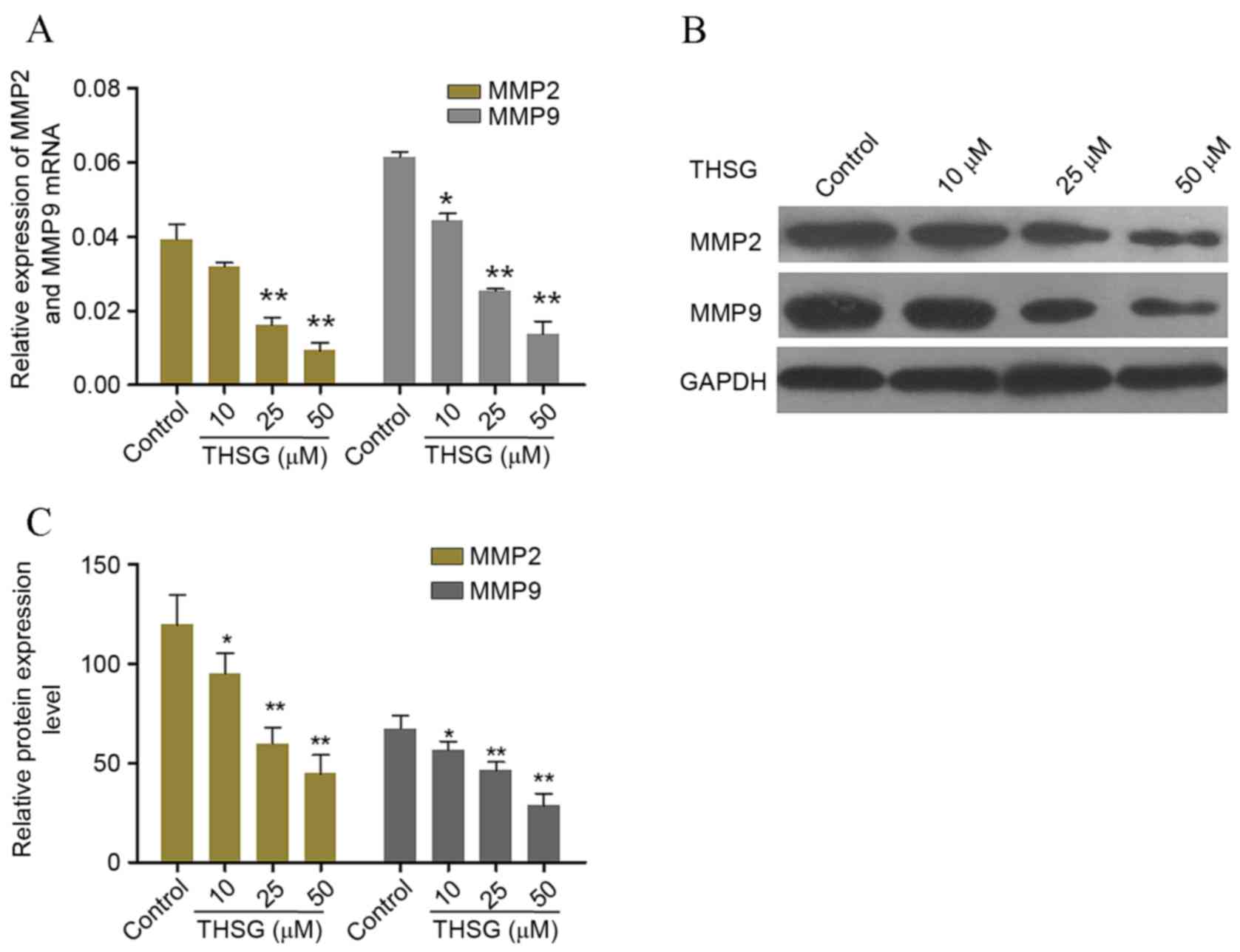2,3,5,4‑tetrahydroxy diphenylethylene‑2‑O‑glucoside inhibits the adhesion and invasion of A549 human lung cancer cells
Retraction in: /10.3892/mmr.2024.13260
- Authors:
- Published online on: October 2, 2017 https://doi.org/10.3892/mmr.2017.7680
- Pages: 8900-8906
-
Copyright: © Xu et al. This is an open access article distributed under the terms of Creative Commons Attribution License.
Abstract
Introduction
Lung cancer is one of the most common cancers diagnosed in China, and is considered to be one of the most common human malignancies that pose a significant threat to human health (1). The global incidence rate of lung cancer is continuing to increase. Chemical and biological carcinogens, including specific viral, bacterial or parasitic infections, lack of trace elements and vitamins, inappropriate eating habits, and genetic inheritance, are associated with the development of lung cancer (2,3). However, the most common cause of lung cancer is smoking; and ~87% of clinical cases of lung cancer are caused by smoking (4). Previous studies have reported that the development of metastases in non-small cell lung cancer (NSCLC) is the most important cause of treatment failure (5–7). Chemotherapy, radiotherapy and surgical treatments are widely used for the treatment of NSCLC. However, the survival rate of patients with NSCLC remains unsatisfactory due to postoperative complications, harmful side effects from therapy, and disease recurrence. Consequently, there is an urgent requirement for the identification of novel and efficient strategies for the treatment of lung cancer. In recent years, the screening of natural plant-derived products used in traditional medicine as potential anticancer agents has drawn significant attention (8,9).
2,3,5,4-tetrahydroxy diphenylethylene-2-O-glucoside (THSG; Fig. 1A) is a bioactive compound derived from Polygonum multiflorum Thunb., which is often used for promoting circulation in Chinese medicine (10,11). Previous studies have demonstrated that THSG possesses antioxidative, anti-inflammatory and antitumor activities (12,13).
In an attempt to identify novel strategies for the treatment of lung cancer, the effects of THSG on the viability, adhesion and invasion of human A549 lung cancer cells were investigated in the present study, and the potential mechanisms involved in mediating these effects were examined.
Materials and methods
Cell line and treatment
The human A549 lung cancer cell line was purchased from the American Type Culture Collection (Manassas, VA, USA). The cells were cultured in Dulbecco's modified Eagle's medium (DMEM; Hyclone; GE Healthcare Life Sciences, Logan, UT, USA) supplemented with 10% fetal bovine serum (FBS; Gibco; Thermo Fisher Scientific, Inc., Waltham, MA, USA) and 1% penicillin/streptomycin (Beijing Solarbio Science and Technology Co., Ltd., Beijing, China) at 37°C in a 5% CO2 humidified tissue culture incubator. To determine the effects of THSG on A549 cell adhesion and invasion, cells were exposedto 0, 10, 25 and 50 µM THSG (Shanghai Yuanye Biotechnology Co., Ltd., Shanghai, China) for 1, 2 and 3 h at 37°C prior to cell adhesion and invasion assays. For all experiments, the concentration of FBS was reduced to 2% and cells were treated for the indicated time periods with stock solutions of THSG prepared using dimethyl sulfoxide.
Cell Counting Kit-8 (CCK8) assay
The viability of A549 cells was assessed using the CCK8 assay (Beyotime Institute of Biotechnology, Haimen, China). Briefly, A549 cells were seeded in 96-well plates at a density of 2×103 cells/well with 100 ml complete culture medium. After incubating cells under standard conditions for 24 h, THSG was added to the medium at a final concentration of 0, 5, 10, 25, 50, 100, 150 and 200 µM. Cells were subsequently incubated for a further 12, 24 and 48 h at 37°C. CCK8 solution (20 µl) was then added to each well and cells were incubated for 1 h at 37°C. The optical density (OD) was read at 450 nm using a microplate reader (Thermo Fisher Scientific, Inc.).
Adhesion assay
Cells growing in logarithmic phase were trypsinized using 0.25% trypsin (Gibco; Thermo Fisher Scientific, Inc.) and were then resuspended in RPMI-1640 (Hyclone; GE Healthcare Life Sciences) medium containing 10% FBS. Cells were then seeded in a 12-well microplate at a density of 1×105 cells/ml before they were incubated for 1, 2 and 3 h with different concentrations of THSG (0, 10, 25 and 50 µM) at 37°C. The supernatant was discarded and cells were washed twice with phosphate-buffered saline (Gibco; Thermo Fisher Scientific, Inc.). Paraformaldehyde (4%; JRDun Biotechnology Co., Ltd., Shanghai, China) was used to fix cells for 15 min, before they were stained with Giemsa (Beijing Solarbio Technology Co., Ltd., Beijing, China) for 30 min. The cells were then washed 3 times with PBS (Nanjing KeyGen Biotech Co., Ltd., Nanjing, China) and the OD was read at 570 nm using a microplate reader (Thermo Fisher Scientific, Inc.). The following formula was used to quantify cell adhesion: Adhesion rate (%)=(OD1/OD0)x100, where OD1 indicates THSG-treated groups and OD0 indicates the control group.
Cell invasion assay
The cell invasion assay was performed using a 24-well Transwell chamber with an 8-µm pore size (Sigma-Aldrich; Merck KGaA, Darmstadt, Germany). The inserts were coated with 50 µl Matrigel matrix (DMEM dilution, 1:2; BD Biosciences, Franklin Lakes, NJ, USA). Cells were trypsinized following treatment with various concentrations of THSG (0, 10, 25 and 50 µM) for 24 h at 37°C, and 1×105 cells were transferred to the upper Matrigel chamber containing 100 µl of serum-free medium and incubated for a further 24 h. The lower chamber was filled with medium containing 10% FBS as a chemoattractant. Following incubation, the cells that had traversed the filter membrane were fixed and stained using 0.1% crystal violet. Cells were visualized under an OLYMPUS microscope (Olympus Corporation, Tokyo, Japan). For each sample, the number of invaded cells was counted in five high-power fields of view selected at random.
Western blot analysis
Cells were first seeded at a density of 5×105 cells/well in 6-well plates, cultured overnight and were then treated with THSG (0, 10, 25 and 50 µM) for 24 h. The cultured cells (1×106) were harvested, washed twice with PBS and lysed in ice-cold radioimmunoprecipitation assay buffer (Beyotime Institute of Biotechnology) with 0.01% protease inhibitor cocktail (Sigma-Aldrich; Merck KGaA) on ice for 30 min. The cell lysate was then centrifuged at 13,000 × g for 10 min at 4°C. The supernatant (30 µg/lane) was run on a 10% SDS-PAGE gel and transferred electrophoretically onto a polyvinylidene fluoride membrane (EMD Millipore, Billerica, MA, USA). The blots were blocked with 5% skim milk, then incubated with antibodies against phosphorylated snail (cat. no. ab53519; 1:500; Abcam, Cambridge, MA, USA), E-cadherin (cat. no. ab133597; 1:1,000; Abcam), Vimentin (cat. no. ab137321; 1:1,000; Abcam), MMP-2 (cat. no. ab37150; 1:200; Abcam), MMP-9 (cat. no. ab137867; 1:1,000; Abcam) and GAPDH (cat. no. ab9485; 1:2,500; Abcam) at 4°C overnight. The blots were then incubated with horseradish peroxidase (HRP)-conjugated goat anti-mouse (1:1,000; cat. no. A0216; Beyotime Institute of Biotechnology) or HRP-conjugated anti-rabbit secondary antibody (1:1,000; cat. no. A0208; Beyotime Institute of Biotechnology) at room temperature for 1 h. Bands were visualized using enhanced chemiluminescence (Thermo Fisher Scientific, Inc.) and quantified with ImageJ software (v1.48u; National Institutes of Health, Bethesda, MD, USA); a total of 3 experimental repeats were performed.
Reverse transcription-quantitative polymerase chain reaction (RT-qPCR)
Human lung cancer A549 cells were seeded at a density of 5×105 cells/well in 6-well plates, cultured overnight and were then treated with THSG (0, 10, 25 and 50 µM) for 12 h at 37°C. Total RNA was extracted using TRIzol reagent (Invitrogen; Thermo Fisher Scientific, Inc.) according to the manufacturer's protocol. Total RNA (2 µg) was reverse transcribed using the First Strand cDNA Synthesis kit (Sigma-Aldrich; Merck KGaA), according to the manufacturer's instructions. PCR amplification was performed for 10 min at 95°C, followed by 40 cycles of 95°C for 15 sec and 60°C for 45 sec, and a final extension at 60°C for 4 mininan ABI 7300 Thermocycler (Applied Biosystems; Thermo Fisher Scientific, Inc.), using SYBR Premix Ex Taq (Takara Biotechnology, Co., Ltd., Dalian, China). Each reaction mixture had a final reaction volume of 20 µl, which was composed of 2 µl cDNA, 2 µl primers, 10 µl Premix Taq and 6 µl nuclease-free water. The specific primer sequences for each gene were as follows: E-cadherin, forward, 5′-GTTGTTGGGCATAGAGAC-3′, reverse, 5′-CAGGGCAGTTTGAATAGC-3′ (product, 125 bp); vimentin, forward, 5′-GCGTGAAATGGAAGAGAAC-3′, reverse, 5′-TGGAAGAGGCAGAGAAATC-3′ (product, 217 bp); Snail, forward, 5′-TTCCTGAGCTGGCCTGTCTG-3′, reverse, 5′-TGGCCTGAGGGTTCCTTGTG-3′ (product, 165 bp); MMP2, forward, 5′-TTGACGGTAAGGACGGACTC-3′, reverse, 5′-GGCGTTCCCATACTTCACAC-3′ (product, 134 bp); MMP9, forward, 5′-AAGGGCGTCGTGGTTCCAACTC-3′, reverse, 5′-AGCATTGCCGTCCTGGGTGTAG-3′ (product, 210 bp); and GAPDH, forward, 5′-CACCCACTCCTCCACCTTTG-3′ and reverse, 5′-CCACCACCCTGTTGCTGTAG-3′ (product, 110 bp). All primers were synthesized by Invitrogen (Thermo Fisher Scientific, Inc.). Target gene expression levels were determined using the 2−ΔΔCq method of relative quantification (14), and all samples were normalized to GAPDH expression, which was used as an endogenous control.
Statistical analysis
The GraphPad Prism software program (version 5.0; GraphPad Software, Inc., La Jolla, CA, USA) was employed for performing statistical analysis of data. Data are expressed as the mean ± standard deviation. One-way analysis of variance followed by Dunnett's post hoc test were used for statistical analyses. All tests performed were two-sided. P<0.05 was considered to indicate a statistically significant difference.
Results
Effect of THSG on human A549 lung cancer cell viability
As shown in Fig. 1B, the in vitro effects of THSG on A549 cell viability were determined using the CCK8 assay. Compared with the untreated control group, 75, 100, 150 and 200 µM THSG significantly decreased A549 cell viability (P<0.05). Therefore, 10, 25 and 50 µM THSG were selected for use in subsequent experiments.
THSG inhibits the adhesion of A549 lung cancer cells
Adhesion of cancer cells to the extracellular matrix and basement membrane is considered to be an initial step in the invasive process of tumor metastasis (15,16). Therefore, the effects of various concentrations of THSG on human A549 lung cancer cell adhesion were investigated. As shown in Fig. 2, 10, 25 and 50 µM THSG significantly suppressed the adhesion of A549 cells at 1, 2 and 3 h, when compared with the untreated control group (P<0.01). These results suggest that THSG may inhibit lung cancer cell adhesion in a time and dose-dependent manner.
THSG inhibits the invasion of A549 lung cancer cells
The invasive capabilities of human A549 lung cancer cells following treatment with THSG were determined using a Transwell assay. As shown in Fig. 3A and B, the invasiveness of cells treated with 10, 25 and 50 µM THSG were significantly decreased when compared with the control group in a concentration-dependent manner (P<0.05 and P<0.01). The invasion rates of cells treated with 10, 25 and 50 µM THSG were 71.25±14.21, 45.24±12.24 and 21.25±8.25%, respectively compared with the untreated control (100%).
THSG alters the mRNA and protein expression levels of Snail, E-cadherin and vimentin in A549 cells
E-cadherin is a tumor suppressor protein that is used as a prognostic marker for patients with esophageal cancer (17). Vimentin is an intermediate filament protein, which interacts with microtubule and actin microfilaments that constitute the body of the cytoskeleton (18). Therefore, E-cadherin and vimentin are reliable indicators for the assessment of cell adhesion. Snail is a transcription factor that regulates the expression of E-cadherin (19,20). RT-qPCR and western blot analyses were conducted to detect the mRNA and protein expression levels of Snail, E-cadherin and vimentin, respectively (Fig. 4). As shown in Fig. 4B, E-cadherin mRNA expression levels were significantly increased in a dose-dependent manner following treatment with 10, 25 and 50 µM THSG compared with the untreated control group (P<0.01). Conversely, vimentin and Snail mRNA expression levels were significantly decreased in a dose-dependent manner following treatment with 10, 25 and 50 µM THSG, as compared with the untreated control group (P<0.05 and P<0.01; Fig. 4A and C). Consistent with the mRNA expression levels, the protein expression levels of Snail and vimentin were significantly decreased, whereas E-cadherin protein expression was significantly increased following treatment with 10, 25 and 50 µM THSG compared with the untreated control group (P<0.05 and P<0.01; Fig. 4D and E).
THSG suppresses the mRNA and protein expression levels of MMP2 and MMP9 in A549 cells
Lung cancer cells produce MMPs, and an increase in the expression of these proteins has been associated with disease progression (21,22). In addition, the expression levels of MMP2 and MMP9 are significantly associated the invasive capabilities of cancer cells (23). To investigate the potential anti-invasive mechanisms of THSG in lung cancer cells in vitro, the expression levels of MMP2 and MMP9 in A549 cells exposed to various concentrations of THSG were detected. Western blot and RT-qPCR analyses were conducted to assess the expression levels of MMP2 and MMP9 in cells treated with 10, 25 and 50 µM THSG. As shown in Fig. 5, THSG exerted significant inhibitory effects on the mRNA and protein expression levels of MMP2 and MMP9 in a dose-dependent manner, as compared with the untreated control group (P<0.05; Fig. 5).
Discussion
NSCLC is characterized by a low survival rate, and is considered to pose a significant threat to human health. Traditional Chinese medicine (TCM) in combination with surgical interventions, radiotherapy and chemotherapy may effectively reduce toxicity and strengthen immune function in patients with lung cancer. In addition, combinations of Chinese and western medicines have been demonstrated to prevent disease recurrence and metastasis, as well as to improve the quality of life and survival rates of patients with cancer (24,25). Therefore, the identification of agents derived from TCM herbs that are effective for the treatment of patients with cancer is of vital importance. THSG is a bioactive compound isolated from P. multiflorum Thunb; therefore, the present study aimed to investigate the effects of THSG on the adhesion and invasion of human A549 lung cancer cells.
Adhesion and invasion are essential during the process of lung cancer cell metastasis (15,26). The development of metastasis is the primary cause of the low survival rates in patients with cancer (27,28). In the present study, THSG was demonstrated to significantly inhibit lung cancer cell viability, adhesion and invasion. In addition, the results provided evidence to suggest that the mechanisms underlying these antitumor effects may be associated with inhibition of Snail, vimentin, MMP2 and MMP9 mRNA and protein expression levels. These results may provide a better understanding regarding the effects of THSG on lung cancer metastasis.
Cadherins constitute a large family of cell membrane glycoproteins that serve important roles in mediating cell-to-cell adhesion. E-cadherin is a prototypical classical cadherin that serves an essential role in maintaining normal epithelial cell structure (29). E-cadherin is a well-characterized tumor suppressor, which is known for its important functions in epithelial-mesenchymal transition (EMT). During EMT, the down regulation of E-cadherin expression leads to loss of epithelial cell characteristics and the acquisition of a mesenchymal phenotype, which promotes cell proliferation, motility and invasiveness, and may contribute to cancer progression (30). Snail is a known transcriptional suppressor of E-cadherin; in human breast cancer, Snail has been demonstrated to suppress E-cadherin expression in vitro and in vivo (17).
Vimentin is a major intermediate filament protein in mesenchymal cells, which serves an important role in cell-to-cell adhesion by associating with hemidesmosomes and desmosomes (18). Snail, E-cadherin and vimentin are regulated by diverse signaling pathways (31,32). In the present study, the mRNA and protein expression levels of Snail, E-cadherin and vimentin were significantly altered in A549 cells treated with THSG.
The initial step of the tumor cell invasion process begins with the breakdown of the cytomembrane, which is known to be dependent on type IV collagen-degrading enzymes, such as MMP2 and MMP9 (22). The expression of MMPs, particularly MMP2 and MMP9, has been associated with an increased potential for metastasis in numerous types of human carcinoma, including lung cancer (23). Western blotting and RT-qPCR analyses were employed to investigate the mRNA and protein expression levels of MMP2 and MMP9, respectively, in A549 cells following THSG treatment. The results demonstrated that THSG significantly suppressed the expression of MMP2 and MMP9.
In conclusion, the results of the present study suggested that THSG may inhibit A549 cell adhesion and invasion potentially by suppressing the mRNA and protein expression levels of vimentin, MMP-2 and MMP-9, which are important factors for the invasion and/or adhesion of lung cancer cells. These results provide evidence to suggest that THSG may be effective for the treatment of patients with lung cancer. However, the mechanisms underlying the antitumor effects of THSG in lung cancer require further investigation.
Acknowledgements
The present study was supported by the Hubei Natural Science and Technology fund (grant no. 2016CFB633).
References
|
Wang L, Yu C, Liu Y, Wang J, Li C, Wang Q, Wang P, Wu S and Zhang JZ: Lung cancer mortality trends in China from 1988 to 2013: New Challenges and Opportunities for the Government. Int J Environ Res Public Health. 13:10522016. View Article : Google Scholar : | |
|
Sulu E, Tasolar O, Takir H Berk, Tuncer L Yagci, Karakurt Z and Yilmaz A: Delays in the diagnosis and treatment of non-small-cell lung cancer. Tumori. 97:693–697. 2011.PubMed/NCBI | |
|
Tamiya A, Naito T, Ono A, Ayabe E, Tsuya A, Nakamura Y, Kaira K, Murakami H, Takahashi T, Endo M and Yamamoto N: Evaluation of the efficacy and safety of chemotherapy for patients with wet stage IIIB/IV non-small-cell lung cancer aged 80 years old or more. Lung Cancer. 71:173–177. 2011. View Article : Google Scholar : PubMed/NCBI | |
|
Vitzthum K, Thielke L, Deter A, Riemer T, Eggeling S, Pankow W and Mache S: Smoking lung cancer patients and tobacco Cessation-is the current treatment in Germany sufficient? Pneumologie. 69:667–672. 2015. View Article : Google Scholar : PubMed/NCBI | |
|
Milano MT, Strawderman RL, Venigalla S, Ng K and Travis LB: Non-small-cell lung cancer after breast cancer: A population-based study of clinicopathologic characteristics and survival outcomes in 3529 women. J Thorac Oncol. 9:1081–1090. 2014. View Article : Google Scholar : PubMed/NCBI | |
|
Abhishekh HA, Balaji AL and Mehta RM: Depression in lung cancer patients. Indian J Psychiatry. 56:3072014. View Article : Google Scholar : PubMed/NCBI | |
|
Asai N, Ohkuni Y, Matsuda M and Kaneko N: Small-cell lung cancer with epidermal growth factor receptor mutation: Case report and review of literature. Indian J Cancer. 51:384–385. 2014. View Article : Google Scholar : PubMed/NCBI | |
|
Chen ZF, Mao L, Liu LM, Liu YC, Peng Y, Hong X, Wang HH, Liu HG and Liang H: Potential new inorganic antitumour agents from combining the anticancer traditional Chinese medicine (TCM) matrine with Ga(III), Au(III), Sn(IV) ions, and DNA binding studies. J Inorg Biochem. 105:171–180. 2011. View Article : Google Scholar : PubMed/NCBI | |
|
To KK, Au-Yeung SC and Ho YP: Differential nephrotoxicity of cisplatin and a novel series of traditional Chinese medicine-platinum anticancer agents correlates with their chemical reactivity towards sulfur-containing nucleophiles. Anticancer Drugs. 17:673–683. 2006. View Article : Google Scholar : PubMed/NCBI | |
|
Huang HP, Gao SL, Wang J, Huang LQ and Huang P: Studies on adventitious root induction in vitro and suspension culture of Polygonum multiflorum. Zhongguo Zhong Yao Za Zhi. 38:3857–3860. 2013.(In Chinese). PubMed/NCBI | |
|
Lee SV, Choi KH, Choi YW, Hong JW, Baek JU, Choi BT and Shin HK: Hexane extracts of Polygonum multiflorum improve tissue and functional outcome following focal cerebral ischemia in mice. Mol Med Rep. 9:1415–1421. 2014. View Article : Google Scholar : PubMed/NCBI | |
|
Chan YC, Wang MF and Chang HC: Polygonum multiflorum extracts improve cognitive performance in senescence accelerated mice. Am J Chin Med. 31:171–179. 2003. View Article : Google Scholar : PubMed/NCBI | |
|
Chen Y, Wang M, Rosen RT and Ho CT: 2,2-Diphenyl-1-picrylhydrazyl radical-scavenging active components from Polygonum multiflorum thunb. J Agric Food Chem. 47:2226–2228. 1999. View Article : Google Scholar : PubMed/NCBI | |
|
Livak KJ and Schmittgen TD: Analysis of relative gene expression data using real-time quantitative PCR and the 2(-Delta Delta C(T)) method. Methods. 25:402–408. 2001. View Article : Google Scholar : PubMed/NCBI | |
|
Xu M, Qian G, Xie F, Shi C, Yan L, Yu L, Zheng T, Wei L and Yang J: Expression of epithelial cell adhesion molecule associated with elevated ductular reactions in hepatocellar carcinoma. Clin Res Hepatol Gastroenterol. 38:699–705. 2014. View Article : Google Scholar : PubMed/NCBI | |
|
Yamada S, Utsunomiya T, Morine Y, Imura S, Ikemoto T, Arakawa Y, Kanamoto M, Iwahashi S, Saito Y, Takasu C, et al: Expressions of hypoxia-inducible factor-1 and epithelial cell adhesion molecule are linked with aggressive local recurrence of hepatocellular carcinoma after radiofrequency ablation therapy. Ann Surg Oncol. 21 Suppl 3:S436–S442. 2014. View Article : Google Scholar : PubMed/NCBI | |
|
Kim A, Kim EY, Cho EN, Kim HJ, Kim SK, Chang J, Ahn CM and Chang YS: Notch1 destabilizes the adherens junction complex through upregulation of the Snail family of E-cadherin repressors in non-small cell lung cancer. Oncol Rep. 30:1423–1429. 2013. View Article : Google Scholar : PubMed/NCBI | |
|
Cogli L, Progida C, Bramato R and Bucci C: Vimentin phosphorylation and assembly are regulated by the small GTPase Rab7a. Biochim Biophys Acta. 1833:1283–1293. 2013. View Article : Google Scholar : PubMed/NCBI | |
|
Mikami S, Katsube K, Oya M, Ishida M, Kosaka T, Mizuno R, Mukai M and Okada Y: Expression of Snail and Slug in renal cell carcinoma: E-cadherin repressor Snail is associated with cancer invasion and prognosis. Lab Invest. 91:1443–1458. 2011. View Article : Google Scholar : PubMed/NCBI | |
|
Muqbil I, Wu J, Aboukameel A, Mohammad RM and Azmi AS: Snail nuclear transport: The gateways regulating epithelial-to-mesenchymal transition? Semin Cancer Biol. 27:39–45. 2014. View Article : Google Scholar : PubMed/NCBI | |
|
Nawrocki-Raby B, Gilles C, Polette M, Martinella-Catusse C, Bonnet N, Puchelle E, Foidart JM, Van Roy F and Birembaut P: E-Cadherin mediates MMP down-regulation in highly invasive bronchial tumor cells. Am J Pathol. 163:653–661. 2003. View Article : Google Scholar : PubMed/NCBI | |
|
Wang J, Shi Q, Yuan TX, Song QL, Zhang Y, Wei Q, Zhou L, Luo J, Zuo G, Tang M, et al: Matrix metalloproteinase 9 (MMP-9) in osteosarcoma: Review and meta-analysis. Clin Chim Acta. 433:225–231. 2014. View Article : Google Scholar : PubMed/NCBI | |
|
Radenkovic S, Konjevic G, Jurisic V, Karadzic K, Nikitovic M and Gopcevic K: Values of MMP-2 and MMP-9 in tumor tissue of basal-like breast cancer patients. Cell Biochem Biophys. 68:143–152. 2014. View Article : Google Scholar : PubMed/NCBI | |
|
Flaws B: Cervical Dysplasia and Prostate Cancer Hpv, a Hidden Link: The Diagnosis and Treatment of Cervical Intraepithelial Neoplasia and Prostate Problems B. 1st edition. Blue Poppy Press; Boulder, CO: 1990 | |
|
Wagner H and Ulrich-Merzenich G: Evidence and Rational Based Research on Chinese Drugs. Springer-Verlag; Wien: 2013, View Article : Google Scholar | |
|
Guo HM, Zhang XQ, Xu CH and Zou XP: Inhibition of invasion and metastasis of gastric cancer cells through snail targeting artificial microRNA interference. Asian Pac J Cancer Prev. 12:3433–3438. 2011.PubMed/NCBI | |
|
Golden DI, Lipson JA, Telli ML, Ford JM and Rubin DL: Dynamic contrast-enhanced MRI-based biomarkers of therapeutic response in triple-negative breast cancer. J Am Med Inform Assoc. 20:1059–1066. 2013. View Article : Google Scholar : PubMed/NCBI | |
|
Babiarz JC, Melaragni F, Kerr S and Kuchimanchi P: Confounding issues in cancer progress-the impact of investor requirements on senior management compensation and regulatory decisions: Tivozanib and Aveo Pharmaceuticals. Therapeu Innovation Regulatory Sci. 49:333–341. 2015. View Article : Google Scholar | |
|
Bae GY, Choi SJ, Lee JS, Jo J, Lee J, Kim J and Cha HJ: Loss of E-cadherin activates EGFR-MEK/ERK signaling, which promotes invasion via the ZEB1/MMP2 axis in non-small cell lung cancer. Oncotarget. 4:2512–2522. 2013. View Article : Google Scholar : PubMed/NCBI | |
|
Bremnes RM, Veve R, Hirsch FR and Franklin WA: The E-cadherin cell-cell adhesion complex and lung cancer invasion, metastasis, and prognosis. Lung Cancer. 36:115–124. 2002. View Article : Google Scholar : PubMed/NCBI | |
|
Wang J and Dong S: ICAM-1 and IL-8 are expressed by DEHP and suppressed by curcumin through ERK and p38 MAPK in human umbilical vein endothelial cells. Inflammation. 35:859–870. 2012. View Article : Google Scholar : PubMed/NCBI | |
|
Toda M, Kuo CH, Borman SK, Richardson RM, Inoko A, Inagaki M, Collins A, Schneider K and Ono SJ: Evidence that formation of vimentin mitogen-activated protein kinase (MAPK) complex mediates mast cell activation following FcεRI/CC chemokine receptor 1 cross-talk. J Biol Chem. 287:24516–24524. 2012. View Article : Google Scholar : PubMed/NCBI |



